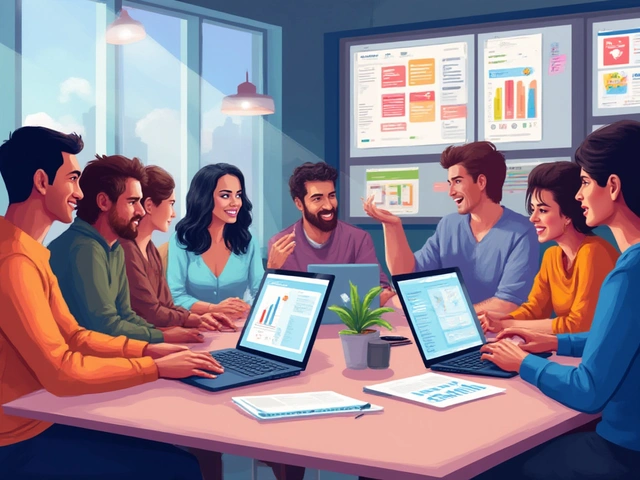Everyone’s talking about AI, but let’s be real—most marketers are just trying to keep up. Tools like ChatGPT are changing the game in online marketing, making it faster and way more personal than ever. If you’re wondering where to actually start or how to ditch time-eating tasks, you’re not alone. Let’s get down to what actually works, what you can automate, the honest limits, and how to stay ahead as everything shifts in 2025.
- ChatGPT is reshaping online marketing by automating copy, content, and customer conversations, making marketers more productive.
- Marketers using ChatGPT report up to 40% faster campaign launches and record-high engagement rates in 2025.
- Getting it right means learning real prompts, setting up solid workflows, and knowing what AI can’t do (yet).
- Top brands are already using ChatGPT for social, email, ad copy, and lead gen—so don’t get left behind.
How ChatGPT Is Transforming Online Marketing Right Now
The old way? Endless hours spent writing copy, brainstorming headlines, or juggling hundreds of customer messages. ChatGPT flips that around. Marketers in 2025 use it for everything from generating catchy social posts to nailing cold outreach emails. According to the 2025 HubSpot survey, 72% of digital agencies say AI writing tools slashed their content turnaround times by at least a third.
ChatGPT marketing is a big deal because it’s not about replacing humans—it’s about automating the grind so you get your time back. Imagine updating product descriptions for 10,000 SKUs without going nuts, running A/B tests where variations write themselves, or deploying chatbots that actually sound human (and don’t frustrate customers to tears).
You’ll see teams using it to:
- Create fresh ad copy for every audience segment—without burning out your writers
- Reply instantly in live chats and support (yep, even outside business hours)
- Whip up detailed blog outlines and first drafts—so your time’s spent polishing, not starting from scratch
- Personalize cold emails by the hundreds, with smart tweaks for every recipient
Step-by-Step: Getting Real Results with ChatGPT in Your Marketing
Here’s where most teams get tripped up—they buy the AI hype, open ChatGPT... and then stare at the screen, unsure how to tame it. Here’s a clear path:
- Pick a Process That Eats Up Your Time
Is it social captions, product copy, blog research, or customer replies? Start with one pain point. My own agency saved 14 hours a week just by automating the first draft of email content. - Develop Clear Prompts
Great output means good instructions. Instead of “Write a blog post,” try “Write a 400-word intro for a mom-targeted kids’ laptop, friendly tone, focusing on screen safety and durability.” - Test and Tweak
Don’t expect perfection off the bat. Run a few samples, edit, then refine your prompt. Keep a cheat-sheet of what works for different project types. - Integrate With Your Tools
Most major platforms—think HubSpot, Salesforce, Shopify—now have GPT plug-ins or built-in features. Save your best prompts as templates inside those tools, so you stop copying and pasting between tabs. - Measure What Matters
Set KPIs that actually tie to business results—like “ad headlines produced per hour” or “percentage of customer chats resolved by AI.”
Here’s a snapshot from a real 2025 agency dashboard showing where ChatGPT moved the needle:
| Task | Time Before (2024) | Time After ChatGPT | Improvement (%) |
|---|---|---|---|
| Email Campaign Drafts | 5 hours | 2 hours | 60% faster |
| Ad Copy Variations | 6 hours | 1.5 hours | 75% faster |
| Customer Chat Responses | — | Instant | Real-time |
| Product Description Updates | 10 hours | 2 hours | 80% faster |
Examples: ChatGPT in Action for Top Marketing Channels
What does success look like at ground level? Here are some concrete examples from brands and agencies using ChatGPT in 2025:
- Social Media: Fast fashion brand BrixtonKids uses ChatGPT to generate 200 tailored Instagram captions per week, each tweaked for product, age segment, and vibe. Their engagement rate jumped 18% this spring compared to last year’s manual posts.
- Email Marketing: A regional e-bike company builds localized newsletters with GPT. Each city gets unique traffic tips, weather notes, and local offers—no more boring, bland blasts.
- Ad Campaigns: Digital agency AltSky sets up “AI-powered headline sprints,” popping client keywords and goals into GPT to generate 50 headline-testers in under an hour. More headlines = more A/B wins.
- Customer Support: Food delivery apps now lean on AI to answer ETA questions, handle refunds, and upsell deals, freeing human agents to tackle the real sticky stuff.
For the record, none of this means you skip editing, fact-checking, or creativity. AI gives you a head start, but the magic is still in human hands. I’ve even let my daughter Tamsin try giving ChatGPT blog topics—she learns fast, but her unicorn-themed suggestions need a touch more reality for B2B clients.

Checklists, Pitfalls, and Pro Tips for ChatGPT Marketing in 2025
Ready to dive in? Here’s what I’ve learned by getting my hands (and inbox) dirty for the last two years with AI-powered marketing:
- Always review AI output for factual errors and brand voice before posting or sending. ChatGPT is quick, but it still blends fact and fiction if you’re not careful.
- Keep a library of your best prompts. The more you tweak, the better your results. Good prompts are gold for saving you time—don’t rely on memory.
- Decide when to be human. For stuff like crisis comms, VIP clients, or delicate situations, skip AI. There’s no shortcut for that personal touch.
- Expect some learning curve. Allow two to three weeks to nail consistent results for each workflow you automate.
Common traps? Relying too much on AI and pushing out bland, ‘robot’ content, ignoring the need for edits, or accidentally publishing embarrassing errors (“Dear First Name”).
Here’s a practical checklist for marketers in 2025:
- Outline specific tasks/processes for AI automation
- Draft and test prompts on safe, non-public campaigns
- Get team buy-in and train on basic prompt engineering
- Plug ChatGPT into your key marketing platforms
- Measure KPIs monthly, not just once, and tune for results
Mini-FAQ: Real Questions Marketers Ask in 2025
- Does ChatGPT create unique content each time?
Yes, with thoughtful prompts and slight tweaks, results won’t repeat. Watch out for generic phrasing, though. - Is AI-generated content safe for SEO?
Google has said quality matters most. As long as content is valuable, fact-checked, and edited, it stands up fine. Don’t publish unedited. - Can ChatGPT learn our brand voice?
It’s not “learning” on its own, but with sample texts and instructions, you can get a pretty close match. - What about privacy—are my prompts stored?
Enterprise versions let you manage data privacy. Standard ChatGPT may use prompts to train by default, so don’t input confidential info. - How much editing do I need?
Plan for a human check—AI can get 80% there but misses context, humor, and sometimes accuracy.
Next Steps for Marketers at Any Stage
- If you’re new: Start with your easiest repetitive task, like writing routine social posts or email drafts. Build a small library of battle-tested prompts.
- If you’ve tried AI but stalled: Audit where you’ve been using it, measure what actually improved, and double down only on what saves you real time or money.
- If you’re scaling: Get your whole team prompt-literate, introduce AI guardrails, and explore full ChatGPT API integrations for campaigns at scale.
It’s not about using every AI feature, but about spending less time stuck and more time building stuff people want. The frontier keeps shifting—jump in now, and tomorrow’s marketing headaches get a whole lot lighter.





